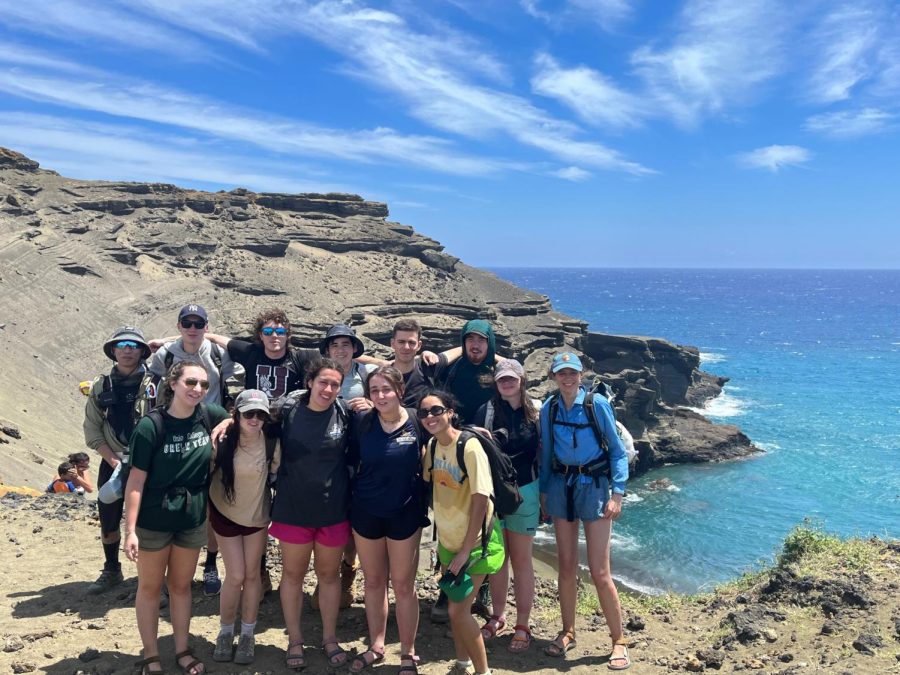GEO 206 class visits Kilauea volcano in Hawaii
April 26, 2023
The students from GEO 206 – Volcanology class visited the Kilauea volcano in Hawaii during spring break. This trip was led by Professor Holli Frey from the Geosciences department, who was accompanied by twelve students who took the class in the Winter Term of 2023. In the class, students learned about the reasons for volcanic eruptions, predicting such eruptions, and the long-lasting impact of such eruptions on society.
The students also had the opportunity to learn about case studies of volcanoes researched by Union faculty members and at the end of the course, the students were proficient in communicating about volcanoes utilizing various forms of media.
Concordiensis reached out to Professor Frey, who elaborated on their visit to the Kilauea volcano.
What was the purpose of the trip to the Kilauea volcano?
This year I took the 12 students in my Volcanology class (GEO-206) to the Big Island of Hawaii over spring break to learn about and experience effusive volcanoes in the field. We spent the term learning about how volcanoes work, why they erupt, and how they are monitored. The Big Island was a natural field laboratory where we could see the impact that volcanoes have on local communities, including the 2022 eruption at Mauna Loa and the 2018 eruption at Kilauea.
What did the students learn about the geology of the area and the eruption history of the Kilauea volcano?
We spent the last week of the term, preparing for the trip. The students learned about hotspot volcanism, the chemical and physical evolution of Hawaiian volcanoes over time, and the types of monitoring done by the Hawaii Volcano Observatory (HVO) of the United States Geological Survey. We did a role-playing exercise in which students were given real data from seismometers, tiltmeters, and GPS, and needed to interpret what type of activity was occurring and whether an eruption was imminent.
On the island, we were able to visit the results of several eruptions from during the last century, including the 1959 eruption of Kilauea Iki which produced a fire fountain nearly 2000 ft. high, the 1969-1974 flows of Maunulu which left behind lava trees and miles of ropey lava flows, and the Kilauea caldera which had >;50 explosive eruptions in 2018 and dropped more than 400 m in depth. We were joined in the field twice by Philip Ong, a friend of mine from graduate school and co-founder of Hawaii Trackers, which interfaces between the community and HVO, and Rick Hazlett, a friend, Professor Emeritus of Pomona College, an adjunct at the University of Hawaii-Hilo, and volunteer with HVO. Both brought an incredible depth of knowledge about volcanology, the history of eruptions on the Big Island, and their personal stories about living in an active volcanic landscape.
How did the trip enhance the students’ understanding of volcanology?
The trip enhanced the students’ learning by allowing them to see the results of processes they learned about in the classroom in the real world. The most common remark from the students was “I didn’t realize how big x was”.
What were the highlights of the trip for the students?
I asked the students on the last night to reflect on their experience and what the highlights were and they included visiting Fissure 8 from the 2018 eruption with the landowner who experienced the lava emerging from his yard and engulfing his home, exploring Kamauna caves (a lava tube from 1880), the hike to Mahana green (olivine) sand beach (one of only four green sand beaches in the world), exploring the cinder cones on the flanks of Mauna Kea, and hiking across the lava flows and shield volcano of Maunaulu to name a few. Every student had a different answer, so I think there were a lot of highlights!
Were there any challenges faced during the trip? What, if any?
Leading an excursion in the field is always challenging, as you need to deal with the logistics of travel, lodging, food, and weather. We stayed in a hostel-like lodge and students prepared dinners for the group in a tiny kitchen, which tested their knife and culinary skills. Our weather was fantastic, but we did have a brief moment of dread when there was heavy rain on our drive to Mauna Kea. However, as we ascended the summit road, we rose above the clouds and were rewarded with amazing views of Mauna Loa and the surrounding landscape.







